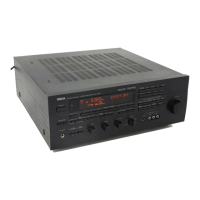
Do you have a question about the Yamaha RX-V890 and is the answer not in the manual?
| Input Sensitivity | 200 mV (line) |
|---|---|
| Weight | 11.5kg |
| Speaker Terminals | Binding posts |
| Power Output | 100 W per channel (8 ohms) |
| Tuning range | FM: 87.5 - 108 MHz |
| Signal-to-Noise Ratio | 100 dB |
| Damping factor | 100 |
| Speaker load impedance | 4Ω to 16Ω |
| Video Connections | composite |
| Input Sensitivity/Impedance | 200mV/47k ohms (line) |
| Tuner Section | FM/AM |
| Audio Inputs | Phono |
| Frequency Response | 10Hz-100kHz (+0/-3dB) |
Explains Yamaha's Digital Sound Field Processor and its benefits for realistic audio environments.
Describes the Dolby Pro Logic Surround Decoder for movie theater realism and its advantages.
Combines Dolby Pro Logic with DSP for enhanced surround effects like movie theaters.
Emphasizes sound position for immersive audio, used in specific DSP programs.
Details the types of speakers required for optimal sound quality with this unit.
Explains five-speaker and four-speaker configurations, including center channel options.
Guides on correctly connecting the unit to other audio and video components.
Describes the terminal for subwoofer output, filtering frequencies above 200 Hz.
Explains the center channel line output for external amplifiers.
Details rear channel line outputs for external amplifiers.
Information on switched and unswitched AC outlets for powering connected components.
Explains how DSP program names and settings are displayed on a video monitor.
Details connecting video sources like camcorders to front panel aux terminals.
Procedure to adjust sound output levels between speakers using a test tone.
Balances output volume between left/right speakers for sound imbalance.
Adjusts low (bass) and high (treble) frequency response for sound output.
Describes the quick auto-search tuning for strong station signals.
Explains how to manually tune to stations, especially for weak signals.
Describes storing station frequencies using preset buttons, up to 40 stations.
Step-by-step guide on how to program desired stations into memory.
Instructions on how to select and play stored preset stations.
Guide for automatic tuning and sequential storage of FM stations.
Selects the center channel output mode (NORMAL, WIDE, PHANTOM).
Adjusts the time difference for sound effects, background noise, and ambient noise.
Adjusts sound output level for center and rear speakers.
Selects one of the 10 digital sound field programs for different listening experiences.
Switches the digital sound field processor (DSP) on or off.
Explains the Dolby Pro Logic Surround system and its use with Dolby Surround encoded sources.
Guides on how to set the unit to turn off automatically after a specified time.
Instructions for deactivating the sleep timer function.
Instructions for installing batteries into the remote control transmitter.
Guidance on when and how to replace batteries in the remote control.
Explains the function of the YPC-USER-LEARN switch for remote control operation.
Lists common remote control problems, their causes, and remedies.
